| dc.description.abstract | Our society is dependent on 24hour services: healthcare, transportation, law enforcement, and fire services, as well as an ever-expanding service sector. The employees who contribute to these 24hour services, collectively called shift workers, suffer the cost of working outside regular daytime hours. Beyond acute health effects such as disturbed sleep and disrupted circadian rhythms, research has unveiled adverse long-term health consequences of shift work, for example, in terms of cardiometabolic health. In this thesis, we examine possible effects of shift work on body-weight related outcomes and lifestyle factors: smoking habits, alcohol consumption, caffeine consumption, and exercise habits. The data used in all three papers stems from The SUrvey of Shift work, Sleep and Health (SUSSH). SUSSH is a large cohort of Norwegian nurses that was initiated in late 2008. The overall aim of SUSSH was to examine possible adverse health consequences of shift work. In paper 1, we investigated possible associations between cumulative night shift exposure and adverse consequences to body weight and lifestyle factors. The cross-sectional data, consisting of 2059 nurses, was extracted from the first wave of SUSSH. The number of self-reported night shifts worked last year (NNL) was used as an operationalization of night work load. Body Mass Index (BMI), obesity (BMI>30), smoking habits, alcohol consumption (Alcohol Use Disorders Identification Test Consumption (AUDIT-C)), caffeine consumption and exercise habits were used as outcome variables and analyzed separately. NNL was found to be significantly and positively associated with BMI, both when evaluated against BMI as a continuous parameter (β =0.055, p<0.05), and when evaluated against obesity (OR=1.01(1.00-1.01)). The AUDIT-C score was found to be significantly and positively associated with hours worked per week, but not with NNL. In paper 2, we build on the main finding from paper 1 and investigated prospective changes in BMI between nurses in different work schedules and changes in BMI and differences in cumulative night shift exposure over a four-year follow-up period. Nurses (n=1244) who reported their work schedules at both baseline and follow-up were included; pregnant nurses at baseline or follow-up were excluded. The shift schedules included were: day-only, two-shift rotation (day and evening shifts), three-shift rotation (day, evening and night shifts), night-only, those who changed to schedule containing night shifts, and those who changed away from schedules containing night shifts. We found that night-only workers, two-shift workers, three-shift workers, and those who changed work schedule away from- or towards night work all had significant BMI gain during the follow-up period. Day-only workers had a non-significant BMI gain. In our multiple linear regression model, we found that night-only workers had significantly larger BMI gain compared to day-only workers (β=0.89 (0.06-1.72)), p<0.05). We did not find any significant association between average yearly number of night shifts (NNs) and BMI using our regression model. Overall, we concluded that night-only workers had significantly larger weight gain than day-only workers. Paper 3 builds on paper 1 in terms of lifestyle factors. In paper 3, we addressed the relationship between shift work and lifestyle factors using a prospective design with six-year follow-up. This subcohort of nurses consisted of 1371 nurses. Different work schedule groups (day workers, night workers, workers starting- and stopping working night shifts), quick returns (≤11h between consecutive shifts; QRs), and NNs were evaluated for their possible effects on changes in caffeine consumption, smoking habits, alcohol (AUDIT-C), and exercise habits. Day workers and the groups with the lowest exposure to QRs (<5) and NNs (<1) were used as contrasts in the respective analyses. A significant increase in caffeine consumption was found across all work schedule groups. Furthermore, declines in smoking prevalence were found among all groups, although they were not significant for those who changed work schedules towards- or away from night shifts. Day workers had a significant increase in the AUDIT-C score. No work schedules were associated with changes in exercise habits. However, our main finding was negative: we did not find any significant between-group differences regarding work schedules, QRs, or NNs on any of the lifestyle factor trajectories. In conclusion, we investigated different characteristics of shift work and changes to body-weight in paper 1 and paper 2. Our findings suggest that night work contributes to weight gain. However, paper 2 failed to replicate paper 1 in terms of a clear dose-response relationship between cumulative night shift exposure and weight gain. The overall conclusion from paper 1 and paper 3, contrary to our a priori hypothesis, is that we did not find any large differences between different lifestyle factors and particular shift work characteristics. Our findings challenge the hypothesis often supported by models trying to elucidate causal pathways between shift work and adverse health consequences. These models often incorporate lifestyle and behavioral factors along a potential causal pathway in conjunction with circadian disruption and insufficient sleep. | en_US |
| dc.relation.haspart | Paper I: Buchvold, H.V., Pallesen, S., Øyane, N.M., Bjorvatn, B. Associations between night work and BMI, alcohol, smoking, caffeine and exercise - a crosssectional study. BMC Public Health 2015;15:1112. The article is available in the thesis file. The article is also available at: <a href="http://hdl.handle.net/1956/11861" target="blank">http://hdl.handle.net/1956/11861</a>. | en_US |
| dc.relation.haspart | Paper II: Buchvold, H.V., Pallesen, S., Waage, S., Bjorvatn, B. Shift work schedule and night work load: Effects on body mass index - a four-year longitudinal study. Scand J Work Environ Health 2018;44(3):251–257. The article is available in the thesis file. The article is also available at: <a href="http://doi.org/10.5271/sjweh.3702" target="blank">http://doi.org/10.5271/sjweh.3702</a>. | en_US |
| dc.relation.haspart | Paper III: Buchvold, H.V., Pallesen, S., Waage, S., Moen, B.E., Bjorvatn, B. Shift Work and Lifestyle factors: A 6-Year Follow-Up Study Among Nurses. Front. Public Health. 2019;7:281. The article is available in the thesis file. The article is also available at: <a href="https://doi.org/10.3389/fpubh.2019.00281" target="blank">https://doi.org/10.3389/fpubh.2019.00281</a>. | en_US |
